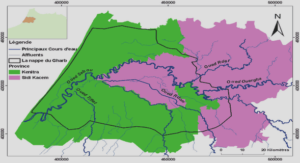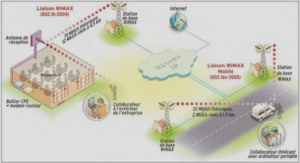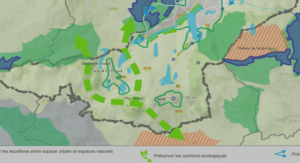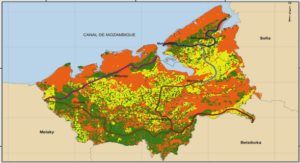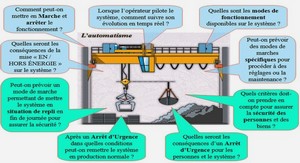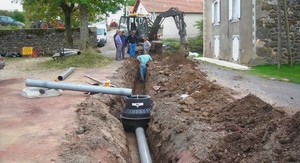Aeronautics contribute to climate change and degradation of air quality around airports through its emissions of greenhouse gases (CO2, water vapor), pollutant gaseous and its particulate emissions (soot, organic aerosols …). In addition, fuels from this transportation sector are mainly fossil fuels. The environmental situation as well as the fear of a future fossil fuel shortage push many researchers to study the reduction of pollutant emissions and use of alternative renewable fuels. In this context, numerous studies are carried out on turbomachines, completed mainly by modeling and numerical simulations for a better understanding aerothermodynamic and chemical transformations. It is recognized that today less carbon monoxide (CO) and less unburned hydrocarbons (UHC) are produced; however, aircraft engines emit nitrogen oxides (NOx), sulfur oxides (SOx) (responsible of acid rain, smog and respiratory disorders) as well as soot (suspected to be carcinogenic) in greater quantity [1-3]. Different systems have been developed to reduce the latter pollutants (NOx, SOx and soot) as well as developments in combustor and turbine technology. However, the future concerning reduction of emissions from engines is more a matter of understanding physico-chemical processes using technologies or developing new fuels. At this level, modeling and simulation of physico-chemical evolutions and turbulence in the high pressure turbine (HPT) seem to be a feasible option, which justifies this project.
Aero-Thermodynamic (AT) evolution
The aero-thermodynamic process in the aircraft engine is a complex process and depends on initial conditions (temperature, pressure, velocity and turbulence), boundary conditions near wall surfaces (cooling systems…), operational function parameters (initial temperature field, rotor speed…), and blade geometry profile. Recent works have addressed this problem but they are mainly based on theoretical calculations or numerical calculations 1D or 2D but very few of them in 3D.
Starik et al. [4] and Lukachko et al. [5, 6] directly used results from AT process experiments to calculate the evolution of chemical species by 1D and 2D calculations. it is considered that in the HPT, temperature and pressure have a negative gradient, linked to the losses in HPT which will be discussed in the next chapters. Rose et al. [7] realized 2D calculations using URANS method to study AT process in a rotor row axial turbine. Nevertheless, the effect of multi-rows (stator rotor), 3D geometry and operational functions of the HPT has not been discussed. For 3D simulations, Lampart et al. [8] calculated the AT parameters in 3D flow of a turbine. The authors modified the blade profiles to increase the flow efficiency. However, the research was studied with a small blade number (3 stator and rotor blades), the cooling effects and operational function influences were still not discussed. Concerning experiments, Yilmaz et al. [9] estimated the relation between exhaust gas temperature and operational parameters in the CFM 56 engine, and Wey et al. (APEX project) [10, 11] measured the emissions and temperature of exhaust gases as a function of operational conditions. However, the AT process of intra-engine was not considered.
Chemical process
The investigation of chemical process in the HPT contains a big challenge because of the complexity of kinetic chemistry in the 3D complex flow, relating to the moving blade at high temperature and high pressure. Similar to the AT process, there is a limited works on the 3D numerical calculations by computer simulation.
In this context, for 0D, quasi-1D (Q1D) and 1D simulations, some authors : Moniruzzaman [12], Bisson [13] and Starik [4, 14] used one of these simulations to study the chemical process in a HPT. These authors argued and explained the transformations of aerosol precursors and particles in post-combustor (turbine and nozzle). Nevertheless, the HPT was replaced by a reactor; this means that the effects of 3D flow, muti-row turbomachinery and source term of rotation of rotor were still not considered. For 1D and 2D simulations, Lukachko et al. [5, 6] calculated the evolutions of chemical species in a row of blade with a chemical package at high temperature and pressure. However, the authors simulated this process in a single blade row. Therefore, the influences of multi-rows, moving blade and dissimilarly of evolution of species in 3D flows have not been performed.
To better understand the formation and the transformation of pollutants, most studies have focused on the principal gas aerosol precursors and soot particles, described as follows:
• Unburned hydrocarbons (UHC)
The existence of UHC (CH4, R-OH …) is due to an incomplete combustion relating to a short resident time, locals lacked oxygen (rich zones) and a low temperature, reducing chemical kinetics. To more complete combustion and reduce emissions, the increase of oxygen, presented in the fuels, would be indispensable. It is also observed that the increase of temperature in the engine can decrease CO and UHC [15].
According to the IPCC, the UHC aviation emission is one of principal sources from the worldwide transport. In this research, UHC evolutions will be considered from the initial conditions to the transformation in the HPT.
• Nitrogen oxides
The family of nitrogen oxides includes the following compounds: nitrogen monoxide (NO), nitrogen dioxide (NO2), nitrous oxide (N2O), dinitrogen tetroxide (N2O4), dinitrogen trioxide (N2O3). Among them, the main toxic gases are the NO and the NO2 (grouped under NOx), two odorous and toxic gases with low dose; mucosal irritation begins as soon as their content (by volume) exceeds 0.0013%. In atmospheric chemistry, NOx gases play an important role in the formation of smog, producing the brown haze often observed over cities, particularly during the summer time (during high-temperature), more environmental problems are caused by NOx pollution. In the presence of rain, nitrogen oxides form nitric acid, contributing to the acid rain problem. Additionally, NOx deposition in the oceans provides phytoplankton with nutrients, worsening the problem of red tides and other harmful algae blooms. Today, NOx is emitted in a large quantity by transport and industry.
The production of the nitrogen oxides takes place at high temperatures. Four main methods have been identified to reduce NOx emissions: i) reducing residence time, ii) increasing dilution, iii) using cleaner fuels and iv) improving fuel injection [15]. In the HPT, these processes may occur at high temperature and high dilution relating moving blade. Thus, understanding NOx transformation is crucial in the NOx evolution in the intra-engine.
• Sulfur oxides
There are more than 30 sulfur oxides (SnOm) of which two common sulfur compounds are sulfur dioxide (SO2) and sulfur trioxide (SO3). The most common sulfur oxide is sulfur dioxide; sulfur trioxide is an intermediate product during the manufacture of sulfuric acid. Sulfur dioxide is a colorless gas with a penetrating, choking odor. Excessive exposure to sulfur dioxide may cause health effects on the eye, lung and throat. Sulphur dioxide is toxic to a variety of plants and may produce visible signs of injury and/or reduce yields of certain crops. Sulfur dioxide gas dissolves in the water droplets in clouds causing the rain to be more acidic than usual. The main emission source of sulfur dioxide is the burning of fossil fuels. Transport vehicles and domestic boilers, as well as natural sources such as active volcanoes and forest fires, release sulfur dioxide. Concerning the air transport, the gas continues to increase in the stratosphere because of the intensification of this type of transport. It is clear that the sulfur oxide emissions depend on the chemical reactions taking place in the engine.
INTRODUCTION |

